
| KIT #: | BM 107 |
| PRICE: | $ Currently OOP |
| DECALS: | Two options |
| REVIEWER: | Kyle Bodily |
| NOTES: | Short run kit with cast metal parts. |

| HISTORY |
The D.XII was a very good aircraft, however it was not as maneuverable as the Fokker D.VII. The Fokker was a stellar aircraft and the Pfalz was never designed to do what the Fokker could. However, when it was not handicapped by second rate engines, it performed the tasks that it was designed for in spades.
With the engine it
was designed for the Pfalz D.XII could out climb, out dive and was faster
than the Fokker D.VIIf. This was because of the wings. The wings were
relatively flat and thin like the French SPAD VII/XIII and the British
SE.5. In fact it was the SPAD’s wing that influenced the Pfalz company to
design the D.XII wings. The thicker Fokker wing allowed the Fokker to
create more lift. But as you increase lift you increase drag.
The trade off was that the Fokker was more
 maneuverable than the Pfalz.
The Fokker fit the underlying German aviator’s philosophy of preferring
maneuverability to speed. Since the Germans didn’t often
cross the lines into Allied airspace as often as the Allied aviators
crossed in to German airspace, the advantage of being able to break and run
for your lines was not as important to the Germans. The Allies preferred
speed over maneuverability. With speed you could accept or refuse battle
at will and in the event things started to turn bad for you, you could
break and run. Return to fight another day, so to say, when luck looked on
you with less of a grimace.
maneuverable than the Pfalz.
The Fokker fit the underlying German aviator’s philosophy of preferring
maneuverability to speed. Since the Germans didn’t often
cross the lines into Allied airspace as often as the Allied aviators
crossed in to German airspace, the advantage of being able to break and run
for your lines was not as important to the Germans. The Allies preferred
speed over maneuverability. With speed you could accept or refuse battle
at will and in the event things started to turn bad for you, you could
break and run. Return to fight another day, so to say, when luck looked on
you with less of a grimace.
Oddly with this philosophy, Allied pilots who flew the Pfalz D.XII after the war liked it and some felt it was even a better aircraft then the Fokker D.VIIf. Arch Whitehouse makes this point quite well in his book ‘THE MILITARY AIRPLANE, its history and development’. He further postulates that had the war gone on for another six months that the Pfalz D.XII would have likely over shadowed the Fokker D.VIIf all together.
Pfalz had experience in building strong fast wings as in their earlier D.III/D.IIIa aircraft. Pfalz aircraft were known for their speed, strength and safety, not always for their maneuverability.
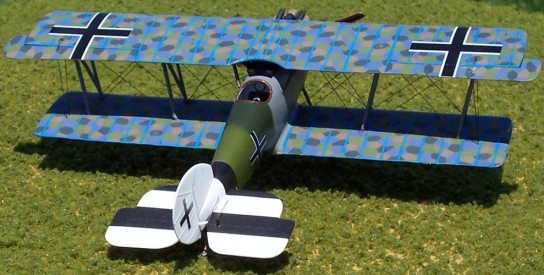 Pfalz Aircraft were
on the average stronger than their flight envelopes. This means that the
aircraft’s structural limitations were inside of their power plant and
aerodynamic limits.
Pfalz Aircraft were
on the average stronger than their flight envelopes. This means that the
aircraft’s structural limitations were inside of their power plant and
aerodynamic limits.
Make no mistake, the Pfalz D.XII was an integral part of the German air service from the spring of 1918. But with a substandard engine, it would never perform as well as the Fokker D.VIIf and because of all the rigging it required, ground crews didn’t have a great affection for it.
The Allies had two aircraft that followed a similar fate and did well by the end of the war. If the war had ended on 11 Nov 1917, the Sopwith Camel and Se-5 would have been remembered in much the same way as the Pfalz D.XII is. It took that extra time, that one more year, to work out the bugs and refine these aircraft into the excellent aircraft that they are now remembered as.
| THE KIT |
This is the old Blue Max kit and is out of production. Since the new Special Hobby kit came out you can pick these kits up for a good price. It is a good kit that builds into an excellent looking model. That being said it is a limited run kit and as such, will not fall together.
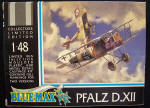 Blue Max/Pegasus
kits are from England. They do only short run kits of aircraft no other
companies are doing or are likely to ever manufacture. However since World
War One has gained in popularity, more and more companies are doing the
same kits. Kind of like the way you see so many of the same P-51s, Bf-109
and Spitfires from different companies.
Blue Max/Pegasus
kits are from England. They do only short run kits of aircraft no other
companies are doing or are likely to ever manufacture. However since World
War One has gained in popularity, more and more companies are doing the
same kits. Kind of like the way you see so many of the same P-51s, Bf-109
and Spitfires from different companies.
Blue Max kits are
made with low pressure-molded plastic so it is softer than you may be
accustomed to. The little detail parts are cast in pewter. The detail
level on the plastic parts is good and crisp with a little flash but no
real problems. They also do not have pull down detail on the wings “hills
and valleys” seen on fabric wings. But this is very hard for a model
company to do correctly. They did do the pinking strip detail, “rib
tapes”, the detail makes the pinking strips almost the thickness of your
thumb. But that is pretty much the way of things. Model companies ether
use too
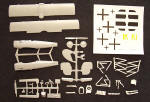 much or too little detail for wings. However on a side note, Roden
is making an excellent effort reproducing wing detail correctly. If you
get the chance, you owe it to yourself to take a look at the most recent
wings that Roden is molding; they are in a word, exquisite.
much or too little detail for wings. However on a side note, Roden
is making an excellent effort reproducing wing detail correctly. If you
get the chance, you owe it to yourself to take a look at the most recent
wings that Roden is molding; they are in a word, exquisite.
The pewter parts are well done with a small amount of mold flash. All the parts are packaged in a small zip-lock bag. Some of the struts and littler parts were bent from shipping but were easily bent back into the correct shape.
 The metal parts
are the guns, gun troughs, all the struts, engine cylinders, radiator,
cockpit bulkheads, cockpit controls and tailskid. The injected parts are
the larger parts including the remaining parts to build the engine. The
softer plastic allows you to cut and reposition the control surfaces easily
if you wish to do so.
The metal parts
are the guns, gun troughs, all the struts, engine cylinders, radiator,
cockpit bulkheads, cockpit controls and tailskid. The injected parts are
the larger parts including the remaining parts to build the engine. The
softer plastic allows you to cut and reposition the control surfaces easily
if you wish to do so.
Instructions are spartan, a single sheet with an exploded view of all the parts. You will need to get a reference book or do some searches on the Internet to see how to build the cockpit and get a better idea of how the aircraft looked. Even a set of three view drawings and a cutaway of the cockpit and engine would be very helpful here. No rigging diagram is provided.
The instructions have color information and some decal instructions. Color info is provided in FS, Methuen and Xtracolor. It is highly recommended that the Windsock Datafile on this plane be used during construction. Decals are provided for the insignia and special markings. Lozenge decals are not provided. So, you will have to get some from an outside source. There are a lot of after market lozenge decals out there and most hobby shops seem to have a set in their decal section.
| CONSTRUCTION |
I removed all the parts from the sprues and cleaned them up. BE VERY CAREFUL DOING THIS!!! The Blue Max plastic parts are soft and the likelihood of damaging them is high if you don’t take your time. I like to use an exacto saw for this.
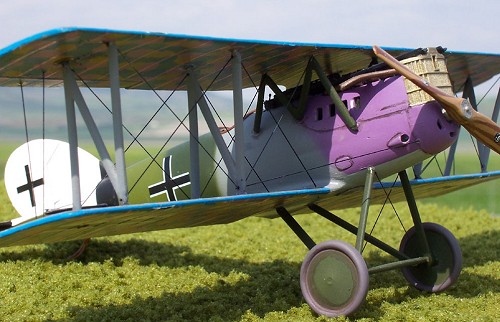 This is a limited run kit so you will
have to fiddle with the parts. I like to fit as many of the parts as I can
before I paint. This reduces the amount of touchup that I will have to do
later. I built the cockpit, glued it in to the fuselage then put the two
halves together. I attached the bottom wings and used a little putty here
to make this joint smooth. I assembled the engine and fit it in to the
body then painted it and glued it into place. I masked off all the
openings and painted the model. The wings were covered with decals and the
pinking strips “rib taped” were drawn on with a paint pen.
This is a limited run kit so you will
have to fiddle with the parts. I like to fit as many of the parts as I can
before I paint. This reduces the amount of touchup that I will have to do
later. I built the cockpit, glued it in to the fuselage then put the two
halves together. I attached the bottom wings and used a little putty here
to make this joint smooth. I assembled the engine and fit it in to the
body then painted it and glued it into place. I masked off all the
openings and painted the model. The wings were covered with decals and the
pinking strips “rib taped” were drawn on with a paint pen.
I always drill all the holes for the rigging prior to final assembly since it is more difficult to drill them after everything is together.
Happily as I started the final assembly the parts went together well. The struts were a help; since they are cast metal they are very strong and add tremendous strength to the model. This also turned out to be the most difficult part of the build for me. Since the struts are metal you need super glue to assemble them and super glue doesn’t give you the ability to adjust the parts very much. So I just did a lot of test fitting here and things worked out fine. I like to rig before I put on the undercarriage. At this point it is just one more thing that can get in the way and make life miserable. We don’t want that.
Well at this point on went the undercarriage, tailskid, propeller and any final rigging.
| COLORS & MARKINGS |
 The instructions
have color information for two aircraft and decals for Pfalz D.XII 2454/18
Jasta 35 and Pfalz D.XII 2486/18 23b. The decals are of good quality and
should work well. Blue Max recommends that the Windsock Datafile on this
plane be used during construction and I recommend it also.
The instructions
have color information for two aircraft and decals for Pfalz D.XII 2454/18
Jasta 35 and Pfalz D.XII 2486/18 23b. The decals are of good quality and
should work well. Blue Max recommends that the Windsock Datafile on this
plane be used during construction and I recommend it also.
I built Pfalz D.XII 2486/18 23b flown by Leutnant Paul Vogel September 1918. He was shot down and killed in this aircraft. The aircraft was recovered by the British and extensively analyzed.
The internal parts were all painted a very light gray. Pfalz aircraft were sealed with pigmented dopes while Albatros used clear dopes. You will see wood grain on an Albatros but you won’t see it on a Pfalz. The fuselage was painted the uniquely Pfalz camouflage bands. If you don’t get the datafile you can use the box art to determine your colors and placement. I hand masked the tail to get the stripes and masked off the bottom before I painted it light blue.
I like the way that masked surfaces look over decals, so I hand masked and painted the tail.
I used the same process to apply the lozenge decals as I did with my 1/72nd scale Toko Pfalz D.XII. In fact this model is just a 1/48th scale version of the same aircraft.
I like to paint the lamination on the propeller by hand as opposed to carving one out of wood. It is just two shades of wood to represent the look of some propellers. Then it gets a very glossy finish. That is about it for the build.
| CONCLUSIONS |
While not the
easiest model kit I’ve ever built it would definitely fit in to the
moderate difficulty level or class. I built it completely out of the box,
except for after market decals a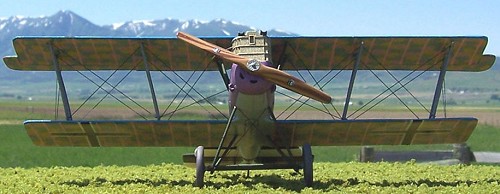 nd an instrument gauge for the cockpit that
came from a left over piece of film used on an old Eduard kit. I think the
build would have been substantially easier if Blue Max would put more
information in their kits, just beef them up a little more. Step by step
processes would help a modeler with less experience to produce an excellent
model.
nd an instrument gauge for the cockpit that
came from a left over piece of film used on an old Eduard kit. I think the
build would have been substantially easier if Blue Max would put more
information in their kits, just beef them up a little more. Step by step
processes would help a modeler with less experience to produce an excellent
model.
I think that WWI aircraft are deceptively difficult and that people get in to trouble when they think that they are in for a Mustang Messerschmitt Spitfire type build. In other words, WWII and Modern aircraft are like apples and WWI aircraft are like oranges. I don’t think you can compare a WWI build to a WWII or Modern build. To say that any WWI kit is as easy as a Mustang Messerschmitt Spitfire type build is like saying that this orange is just like this apple even if it is the best orange in the world, it is still an orange. If all you’ve built is WWII and Modern, then building WWI may be difficult even unpalatable at first. But try an orange again with an open mind and taste it for what it is. I think that you will like WWI subjects as much as I do, who knows maybe you’ll like them even more.
August 2005
| REFERENCES |
“Windsock Datafile
#41 Pfalz D.XII” Albatros Productions LTD
“Jane’s All the Worlds Aircraft 1919” (Jane’s Fighting Aircraft of World
War I)
“The Ministry of Munitions Report November 1918”
“The Pfalz D.XII Profile Publications #199” Profile publications Ltd.
“THE MILITARY AIRPLANE it’s history and development” By Arch Whitehouse, Doubleday & Company, inc.
If you would like your product reviewed fairly and fairly quickly, please contact the editor or see other details in the Note to Contributors.